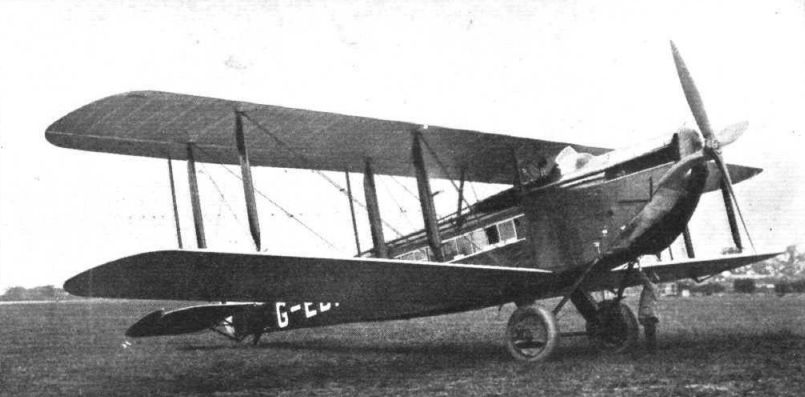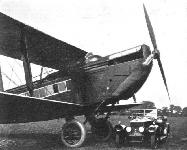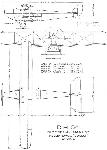
Варианты
- De Havilland - D.H.18 - 1920 - Великобритания
- De Havilland - D.H.32 / D.H.34 - 1921 - Великобритания
- De Havilland - Highclere / D.H.54 - 1925 - Великобритания
Flight, February 1925
NEW DE HAVILLAND AIR LINER
D.H.54, with Rolls-Royce "Condor," to Carry 14 Passengers
AMONG the new commercial aeroplanes planned for 1925 and now nearing completion, is the 14-passenger de Havilland 54, which is to be fitted with a single Rolls-Royce "Condor" engine. This machine, the construction of which is expected to be completed in about a month's time, is a typical de Havilland in its general lines, and might be described briefly, although not very accurately, as an "overgrown D.H.34." The general lay-out and many of the constructional features are the same, but a closer inspection reveals certain not inconsiderable differences.
The general arrangement drawings published on the next page show the lines of the D.H.54, from which it will be seen that the machine is a normal two-bay biplane, with the top plane straight and the lower set at a considerable dihedral angle. A feature of the D.H.54 will be the provision of camber gear similar in principle to that first tried out on the type D.H.50 with such success. This gear, it may be recollected, consists in a hinged trailing edge pulled down by the action of springs and rising under increased air pressure with increase in speed. The gear is entirely automatic in action as regards the variable camber function, but the flaps are divided, the outer portions retaining their differential movement and aileron action. The advantage of this flap gear is two-fold: it reduces the stalling speed considerably, and, what is almost of as great importance for a passenger machine, it allows of approaching the aerodrome with the fuselage practically horizontal, because the effect of the camber gear is to increase the angle of incidence as well, so that with the tail down but a few degrees the wings are at the angle of maximum lift. There may be a third and less obvious advantage with the sprung flaps in coming out of a stall. Certainly, in the D.H.50, the drop is very small before the machine flattens out after a stall, and it is thought that the D.H.54 may to some extent have the same characteristics.
Constructionally, the D.H.54 follows previous de Havilland practice m that the fuselage is a ply-wood-covered structure devoid of wire or tie-rod bracing. In the new machine, however, a departure from usual practice is to be found in that the fuselage is in two sections, so as to facilitate ground transport. The joint in the fuselage occurs just aft of the cabin door, and actually the two spare seats and the lavatory are in the tail portion of the fuselage. The joint is in the form of bolts through the longerons, with fish-plates inside and out. Each portion is a complete structure in itself, and the joint between the two portions is covered with a fabric strip so as to make the fuselage watertight - at any rate, the cabin portion of it and the first two bays aft of the joint, at the end of which is a watertight bulkhead.
The rear portion of the fuselage is provided in each bay with large openings in the bottom, the object of which is to give access to the interior for purposes of inspecting the structure. In actual use these openings will be covered over with doped fabric.
Unusual head-room characterises the main cabin of the D.H.54, in which there will be seating accommodation for 12, or possibly 14, passengers. The roof structure shows curved beams of built-up box section, and even under these beams the head-room is about 6 ft., while between the beams the distance from floor to roof is some 6 in. more. The permanent seats are arranged in three rows, two close together on one side and a single row on the other, with a narrow gangway running between. Behind the permanent seats, and against the rear wall of the cabin, is another spare seat with room for two passengers. Aft of the cabin is a large lavatory with the usual fittings. The door to the cabin is placed on the starboard side, and provision is to be made for making a watertight joint between door and door-frame, so that in case the machine should be forced to alight on the sea, it will, it is expected, keep afloat for many hours if need be. It may be recollected that experiments were carried out at Felixstowe last year with a D.H.18 in order to determine how long a land machine with its cabin made watertight would remain afloat. The D.H.54 will incorporate the experience thus gained.
One of the difficulties of preventing an aeroplane from submerging on alighting on water is that the undercarriage usually causes the machine to nose over, so that a fair amount of water gets into the cockpits and cabin. In the D.H.54 this will be guarded against by arranging the undercarriage so that it, or at any rate part of it, can be dropped when the pilot realises that a forced descent on the water is unavoidable. This is accomplished as indicated in the accompanying sketches. The undercarriage, which is of the usual De Havilland Vee-type, except that the shock-absorbing gear is in the form of rubber blocks working in compression and incorporating oleo damping gear, has its front legs cross-braced in the usual way, but the rear bay has no such bracing. At their upper ends the rear legs are attached to the lower longerons by means of a substantial bolt, and this bolt can be withdrawn by the pilot by means of the mechanism shown in the sketch and a lever in the cockpit. When the bolt is withdrawn the undercarriage is free to drop, and in so doing the hook attachment of the axle to the front chassis struts allows the former to fall free, the front struts and their bracing remaining in place on the machine, but swinging free so that on impact with the water they will be forced back and up against the bottom of the fuselage. It is not thought that the presence of these struts will cause any appreciable tendency to nose over.
The cabin of the D.H.54 is lighted by large windows in the side, and heating and ventilation has been arranged for, hot air from a muff around an exhaust pipe being admitted through a diffuser near the floor, and fresh air, forced in by a scoop placed in the roof, being admitted through another diffuser placed at head level. The amount of hot and cold air admitted can be regulated by the passengers themselves, a regulator being placed on the front wall of the cabin. Emergency exits are provided in the roof, and take the form of circular openings covered with fabric.
The pilot's and navigator's cockpit is situated ahead of the top plane, between it and the engine, and as the pilot's seat is raised and the coaming around it forms a "hump," the view forward and laterally should be quite good. The Rolls-Royce "Condor” engine is mounted on a composite wood and metal structure, and the nose of the fuselage terminates in a nose radiator provided with shutters for varying the cooling.
Direct gravity feed is provided, the petrol tank, which is in the form of a deep wing section, occupying the whole of the top centre section, with direct supply to the engine.
It is not yet possible to give complete details of the D.H.54, but it may be stated that the total loaded weight will be in the neighbourhood of 11,000 lbs. As the wing area is 1,005 sq. ft., this will give a wing loading of very nearly 11 lbs sq. ft., which seems quite high enough. A top speed of 110 m.p.h. is expected, and a cruising speed of 100 m.p.h. On a basis of 700 b.h.p. the power loading is 15-7 lbs./h.p., and the power expenditure, for full load, will be only 50 h.p. per passenger, which is a very reasonable figure in view of the high cruising speed. We have not seen the performance curves of the machine, and so do not know what the horsepower required at cruising speed is. There seems, however, to be reason to believe that this is fairly low, as the machine is of clean lines, and it may therefore be expected that the D.H.54 will be a really commercial machine, and will bring the day closer when civil flying becomes self-supporting.
Описание:
- Flight, February 1925
NEW DE HAVILLAND AIR LINER - Flight, June 1925
NEW DE HAVILLAND PASSENGER MACHINE
Фотографии
-
Flight 1925-06 / Flight
Регистрационный номер: G-EBKI [9] The D.H.54 with Rolls-Royce "Condor" engine has seating accommodation for 14 passengers.
-
Aeroplane Monthly 1974-02 / P.Moss - Wings for the Empire (2)
Регистрационный номер: G-EBKI [9] The one-off D.H.54 Highclere, G-EBKI, loaned to Imperial Airways for evaluation in 1926.
-
Flight 1925-06 / Flight
Регистрационный номер: G-EBKI [9] The D.H.54 is a very large single-engined machine, and in this photograph the Rolls-Royce car standing under the nose gives an excellent idea of the relative size.
-
Aeroplane Monthly 1977-12 / Personal album
Регистрационный номер: G-EBKI [9] The one and only D.H.54 Highclere, G-EBKI was first flown on June 18, 1925, by Hubert Broad. After use by the Air Council ’KI was lent to Imperial Airways for evaluation but was never used. It was destroyed on February 1, 1927, when a hangar, heavily laden with snow, collapsed and crushed it to matchwood. The Highclere featured a jettisonable undercarriage for emergency ditching and camber-changing flaps.
-
Aeroplane Monthly 1998-10 / R.Riding - A Broad experience (1)
Регистрационный номер: G-EBKI [9] The D.H.54 Highclere 12-passenger airliner was designed for use by Imperial Airways, but in 1926 the company decided not to carry passengers in single-engined aircraft, so the D.H.54 never entered service with the airline. Plans to use the Highclere as a freighter came to naught after it was destroyed in a hangar collapse during a snowstorm at Croydon in February 1927.
-
Aeroplane Monthly 1998-10 / R.Riding - A Broad experience (1)
Регистрационный номер: G-EBKI [9] As Long as it is Broad: This photograph of the nose of the D.H.54, or "Highclere" as the machine has been officially named, showing Capt. Broad getting into the cockpit, gives a good idea of the size of this latest de Havilland air liner, which is fitted with a Rolls-Royce "Condor'' engine of 650 h.p.
Hubert Broad scaling the massive 68ft 2in-span D.H.54 Highclere G-ABKI (G-EBKI ???) to reach the cockpit. Stretching away in front of him is the 650 h.p. Rolls-Royce Condor engine. Broad made the first flight of the one-and-only D.H.54 on May 25, 1925. -
Flight 1925-02 / Flight
Регистрационный номер: G-EBKI [9] The D.H.54 Commercial Aeroplane (Rolls-Royce "Condor" Engine): The fuselage nearing completion in the Stag Lane shops.
-
Flight 1925-01 / Flight
Регистрационный номер: G-EBKI [9] A NEW DE HAVILLAND AIR LINER: The fuselage of the D.H.54 in course of construction at the Stag Lane Works of the de Havilland Aircraft Company. The men alongside give some idea of the size of the machine, which will carry 14 passengers. The power plant is to be a Rolls-Royce "Condor."
-
Flight 1925-03 / Flight
Регистрационный номер: G-EBKI [9] The new De Havilland Air Liner: The Rolls-Royce "Condor" has now been installed in the new D.H.54, as shown in our photograph, taken recently in the Stag Lane works.
-
Flight 1925-06 / Flight
SOME CONSTRUCTIONAL DETAILS OF THE D.H.54: 1, The rear chassis strut is attached to the lower longeron by a fork-end and pin; when the pin is withdrawn, by means of the crank and rod shown, the leg is free to drop; 2 shows details of the hook attachment of axle to front chassis strut; while 3 and 4 are diagrammatic representations of the manner in which the undercarriage drops. The front struts remain on the machine, but swing free. 5 gives details of the rib construction, and 6 shows a spar root, with strut attachment and wiring lugs.
-
Flight 1925-06 / Flight
D.H.54 Commercial Machine Rolls-Royce "Condor" Engine
- Фотографии










